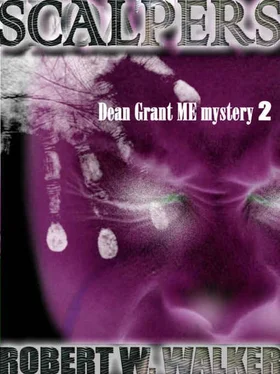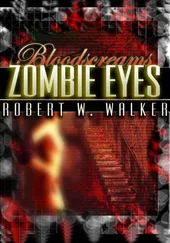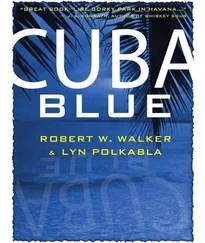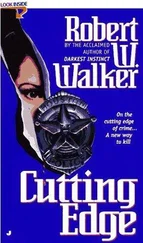"I bet he shit tacks, too,” replied Sid.
"Had you followed the killer here?” asked Dean.
"Not exactly, no ... not until the first scalping occurred. More than a year has elapsed since the Seneca deaths."
"In Michigan, was anyone brought in for questioning? Were there any arrests?"
"Nothing that could stick ... a handful of young bucks from an Indian reservation not far away, but the arrests were foolish to begin with. This killer, whoever he is, has his own reasons for scalping."
"Well, we have a lot of work to do,” Sid said, returning to his lab work. Dean saw that Park was curious about what it was they were doing. “We're running sub-atomic tests on the suspect's hair to determine the intake of arsenic, lead, silica, and such."
"That tell you what sort of diet the guy has?"
"Right. So far, it's a fairly anemic diet ... thin on natural foods. It might tell us something about occupation, and perhaps any medication. For instance, if the guy is a candidate for cancer, or is a diabetic. The chief constituents of hair are carbon, nitrogen, hydrogen, oxygen, phosphorus, and sulfur. But trace elements are as variable as fingerprints. These elements can only be determined through atomic bombardment."
"I see.” Dean knew the detective did not see at all, but he nodded anyway.
"What do you do with the soil samples you took out at the park?” the lieutenant asked.
"Sid and I are used to pursuing every small scientific clue. We've been indoctrinated in the methods of seeking microtraces, which comes down to applying adhesive tape everywhere."
"Yeah, I saw you press tape into the girl's scarf and onto her bag, and even her shoes."
"Several mosslike particles of soiled vegetation were clinging to her things."
"Not moss, Dean,” said Sid. “While you were away, Tom Warner ran tests on your ‘moss.’ It was flecks of fat."
"Fat?"
"Yeah, pure fatty tissue ... human fatty tissue, the girl's own, dropping in flecks when they cut chunks from her."
"Christ,” said Park.
"Well, as for the soil samples taken from the girl's clothing and from the surrounding terrain, I sent samples of it to my lab in Chicago for examination,” explained Dean.
Park shook his head, “Why to another lab?"
"This process will determine if she was indeed murdered at the site, and not merely dumped there after the scalping, if the two samples correspond."
"But why to Chicago? Couldn't that have been done here?"
Sid stopped in his work to listen for this answer himself.
"I have a soil specialist in Chicago. Besides, it's best that we have two such tests conducted at two separate labs whenever possible."
Park nodded, understanding. “Isn't it strange the scalp taken is always in the range of nine inches by four? When I was a boy, I don't know, I always thought of scalps as circular. Now someone's teaching me different, that they can be diamond-shaped, triangular, square. Did you know that when a U.S. cavalry trooper on the plains in the 1800's found scalped bodies, their Indian scouts knew immediately which tribe was responsible?"
"From the shape?"
"Shape, depth, additional markings of mutilation on the corpse's limbs, thighs, all that—yeah."
"You've gotten into this stuff pretty heavily, Park."
Park bit his lip, looking as if he were sorry to have gone on for so long. “Some, I guess."
"What else might you be able to tell me, Lieutenant?"
"About the armpit slashing..."
"Yes, go on."
"Well, American Indians would take any portion of unusual skin. Tattoos, for instance, were stripped from the dead in whole pieces, cured, and hung in teepees for decorations. They were highly valued. Armpit, crotch, and sometimes the entire upper half of a human skin from face to crotch was stripped away, depending on the strength of the enemy."
Dean had never heard of such things before. “Are you certain?"
"Peculiar value was set upon such things as good and powerful medicine. My grandfather was part Sioux."
Dean picked out the Indian features now, muted as they were. “You think our mad killers are making powerful medicine?"
"Could be."
"You think it's Indians?"
"Not necessarily, but if it so, the killers have reasons for what they're doing."
"The same way apemen had reasons, maybe."
"Doctor?"
"Anthropologists studying the skull of Ethiopia's Bodo Man—a predecessor of homo sapiens—removed some encrusted dirt and rock and deduced that the flesh had been stripped away from the head with stone tools. But at least the apemen had done the deed after the creature's death, that much could be determined ... but not the purpose.
"Hell, the Parthians took hair from slain enemies to decorate their weapons and clothing in the fifth century B.C. Trust me, it's a much older white tradition than it is a red tradition.
"It crosses all colors—all nations, actually,” Dean replied. “And it happened everywhere, in every time—the Mediterranean, Byzantium, Spain, the Carribean, Asia, you name it."
"And when neatly done, it may be termed a satanic accomplishment—I think that is how one white writer put it,” said Park philosophically, almost to himself. Then, to Dean, he added, “So, you've done a little reading on the subject yourself, Doctor?"
Dean nodded. “History is full of horror."
"I hope you find what it is you're looking for, Dr. Grant,” he said, indicating the lab. “See you later, perhaps."
Sid walked over to where Dean stood and said, “Wonder what that was all about."
"Don't know..."
"But I bet you're anxious to hear if his story checks out, right?"
"At this point, we can't overlook the man's past."
"Yeah, that story about Vietnam, now that was eerie."
"Eerie, yeah ... just eerie enough to be true."
Sid stared at Dean. “You don't really think there's a connection, do you?"
"A lot of killers find confession—even masked confession—a cathartic experience, Sid. It cleanses their hearts long enough to enable them to commit the next act."
"Park? One of our own cops? Come on, Dean."
"He shows up around the time of the first killing, gets himself reassigned here as a result of the first killing ... we've got to look closely at the dates and vouchers."
"But Dean, he didn't have to tell you all that stuff about Seneca, Michigan. He just did, and of his own free will. If he had anything to hide—"
"Smart move, if he is guilty, wouldn't you say? And from the start, my friend, I've had the feeling we're not dealing with a mental patient. This guy plans too well, leaves no trace, and controls an accomplice."
"You seem to thrive on this, Dean, but I'll tell you truthfully—I'd much rather get back to my lab work than to go shadow dancing with a frigging mass murderer."
"I wonder what Hamel, our resident shrink, thinks of Park. Be interesting to find out."
"You do that. I'm getting back to work right here. I don't know how long I can stave off the D.A., but I'm going to fight this damnable action all the way."
"That's the spirit,” Dean almost shouted. “I think now I'll see if I can't find Dr. Hamel."
"Sure, do that ... leave me to fight the good fight all alone,” began Sid, but he was talking to an empty room. Dean was already at the elevator and Sid frowned from his side of the glass.
The plaque on Hamel's door read Dr. Benjamin I. Hamel, Police Psychiatry. Dean hesitated at the door. As a rule he agreed with Peggy Carson: not too many police shrinks had impressed him. Stephens in Chicago was a rarity. He wished he had Stephens with him on this case the same way he wished he had Kelso by his side—people he could trust and be at complete ease with—but that wasn't to be and he must make do. These thoughts born-barded Dean when suddenly the door opened and Hamel stood before him, about to depart.
Читать дальше












